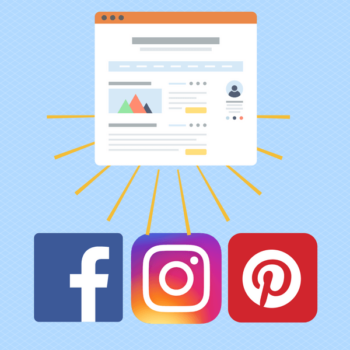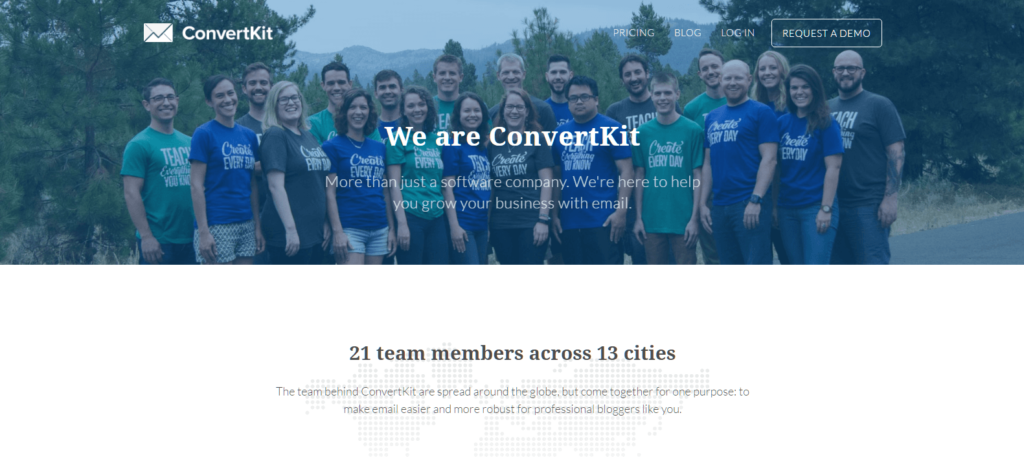Episode: 287
Who: Mark and Lauren Greutman
Website/Blog: LaurenGreutman.com
Do you want to grow your email list, but you’re not sure where to start?
Are you sick of relying on social media to bring you traffic?
In today’s episode, I’m on the line with Mark and Lauren Greutman. They run one of the largest personal finance websites in the country: LaurenGreutman.com. Lauren is a regular guest on the TODAY show, Dr. Oz, Fox & Friends and many more national TV shows, as well as the #1 best-selling author of The Recovering Spender. Mark is the content and website manager, as well as an email and paid advertising guru. Together, they work hand in hand to continue to build up their email lists using multiple strategies, which often net them 750 email sign ups per day. You’ve heard me say it before: your email list is one of your most valuable assets. So Mark and Lauren are here to share their secrets for boosting growth on your email list.
Listen to this Episode
Mark and Lauren’s Story
It’s Mark’s first time on the show, but Lauren has actually been here twice before! If you want to know more of the backstory, check out Episode 147: How to Get Media Exposure for Your Blog and Episode 173: A Pinterest Strategy That Makes Sense.
The last time Lauren was on the podcast, Mark had just quit his job as an actuary to come home and work with Lauren full time. Both of them say that the first year working together was difficult, but now they’re in a good groove.
I had two questions right away: what does an actuary do? And why was that first year so rough?
Mark says that an actuary basically does lots of number crunching. You can find them in many different places, but he worked on pension plans and healthcare. As a result, he’s really, really good at spreadsheets. He’s got a spreadsheet for everything, which is super helpful when it comes to the email list!
The first year was rough because Mark stepped into Lauren’s world, but they hadn’t set out clear roles ahead of time. The website had been up and running for four years at that point, and the business was doing well. But Lauren wasn’t prepared for taking on another full-time employee. At the time, she would do things because she knew they worked, but she wasn’t necessarily able to explain them to someone else.
Mark will also be the first one to tell you that he didn’t understand Lauren’s audience at first. He would spend all day writing some amazing content, only for Lauren to throw it out because it wasn’t speaking to their audience.
Mark and Lauren also have four children, and they didn’t plan out clear roles or put together a schedule for who would do what around the house when Mark left his job. There was also a lot more pressure for the blog to be successful once they didn’t have the fallback of Mark’s separate income. So basically, Lauren says, “It was just a big, jumbled mess.”
So what happened? How did they get out of the mess?
Lauren’s book deal was a game-changer. Once she got offered the book deal about a year ago, she had to let a lot of things go. It was physically impossible for her to write and promote the book and do the website full time and be a full-time mom and cook dinner every night. So the book helped Mark and Lauren to find a balance.
Let’s Talk Email Lists
Was an email list always a priority for Lauren?
Nope. She did an RSS email for years.
Then two years ago, when Facebook had its big algorithm changes, Mark and Lauren decided they needed to build their email list. They realized that they couldn’t just be dependent on social media to reach their audiences any more.


So they stopped the RSS emails and started writing emails to the list with a much more personal tone. Lauren says she doesn’t use “form emails,” where you’re just getting a digest of new content. It has to look like you personally have written the emails. You’ve got to write them as if you were writing to a close friend.
Mark and Lauren also started offering freebies for signing up the email list. They’ve got different freebies available depending on what content you’re looking at when you sign up.
They’ll also start the email with your first name, when possible. Now, it’s true that the more details you ask for when someone is signing up to an email list, the less likely they are to sign up. Mark and Lauren only ask for your first name and your email address, most of the time. But on the mobile version of the site, they only want your email address, because it’s harder to fill in multiple fields on a phone or tablet.
Mark and Lauren use ConvertKit to manage their email marketing, but Lauren also responds to every single email that comes to their inbox.
Wait, what?! 750 new subscribers per day, and she answers every single email?!
Yes! Lauren is careful to say that she only gets about 20 emails per day, even though they have lots of new subscribers. And she does use some canned responses, if people send frequently asked questions. But she does spend one to two hours per day just answering email.
This really sets the blog apart: Lauren and Mark are willing to invest in the people who come to their website. The community is everything. Lauren says, “if we don’t have them, we don’t have anything.”
Where Do I Start?
So if I want to build my email list the way that Mark and Lauren have, where should I start? How do I up my marketing game?


The first thing, Mark says, is to think about what kind of people you want on your list. Then, make sure that your freebies match the audience you’re targeting.
For example, Mark and Lauren were previously giving away a meal plan as a freebie, but they have since changed the focus on their blog. Where they were more about food before, now they are more focused on budgeting and debt reduction. So the meal plan giveaway no longer attracts the right kind of audience.
You need to think about who specifically you’re targeting, even within your niche. What are their needs and problems? Then, think about what you can create that will be attractive enough to them that they’ll want to sign up to your list.
You also want to offer a ton of value in your free giveaway. This helps to build trust in you and your brand. Don’t just throw them a one-page printout. Lauren says that kind of thing is just “lame.” Instead, really “knock their socks off.” Lauren and Mark are currently offering a 15-page budget pack with an explanation of how to use it and a customized spreadsheet. That’s the kind of thing they could charge for, but they’re happy to give it away if it gets people in the door.
One thing that stands out to me is the utility of that budget pack. This freebie is something that Lauren and Mark’s email subscribers will use every day in their life or in their business. And because the spreadsheet is branded, they’ll be reminded of LaurenGreutman.com every time they open it. Genius!
So think: if you were in the position of your target reader, what would actually be useful for you? I could picture giving away an affiliate tracker spreadsheet, or an income tracking spreadsheet for bloggers, for example.


Okay, so you’ve created your awesome resource to give away. Now what?
Write a really creative, compelling, long form piece of content with an emotional hook that gets people to sign up for your list. For example, Mark and Lauren recently did a post called “How to Budget When You Don’t Make Enough Money.” It hits all the pain points of people in debt or up at night worrying about bills.
The invitation to download their budget pack is embedded in the article copy, repeated at the end of the article, and in a pop-up. So a reader has three different opportunities to sign up.
Using Social Media Advertising
Then, once you have the content, get it out there on Facebook, Pinterest, and Instagram.
Keep in mind that you’ll pay less for ad space if you are promoting content. It costs significantly less to promote a blog post as compared to a landing page.
Your goal is to get people to this piece of content in the cheapest way possible. The secret? Really good copy for the text you see on the ad itself. This is so important. It has to be super engaging if you want the cost per click to go down–which you do!


The first step to creating amazing copy is to test it out with organic reach. Mark and Lauren have 134,000 Facebook fans, so they can usually tell within the first hour if something they’ve posted is doing really well and is worth promoting. We’ll stick to tips for Facebook here, since that’s where most of my audience is focusing.
That might seem intimidating if you only have 500 or 1,000 followers, but your audience are still the best gauge of how strong your copy is. If you normally get 5 shares, but something you post gets 20 or 30, you know you’re onto something.
Mark also emphasizes that shares and click-through rates are much more important statistics than likes when testing your copy. Then, when you set up your ad campaign later on, make sure you’re measuring clicks, not engagement.
In the organic phase, it can be good to test copy by posting the same content a few different ways. Or, you can just go in and edit a post that isn’t performing as well as you’d like. Mark and Lauren have done this before, and they always see an increase in engagement once they adjust the copy.
You want to be paying attention to your RPM. That’s your ad revenue per 1,000 page views. If you know your RPM, and you divide that number by 1,000, you’ll have a rough sense of your ad revenue per page view. So if your RPM is $10, you’re getting a penny per page view.
So now, the goal is to get people onto your site for a penny each, because then that’s free traffic. In other words, you want to be earning the same amount from each visit that you’re paying for each click. And then, once they’re there, everything you make through autoresponders and your own products and affiliate links is “gravy.”
Getting Cheap Clicks
Sounds good, but these are hypothetical numbers. Like, it’s not possible to get down to a penny per click…right?
Actually, Mark and Lauren say, “YES.” It is definitely possible to get down to a penny per click. It takes some testing and experience, and it won’t happen every time, but it is possible. They’ve done it.
So how do we get those cheap clicks? Unfortunately, there’s no single formula that works every time. Mark said that it takes testing. So what does he test? And how?
You’ve got to test all kinds of things: the audience you’re targeting, the image you’re using, the copy… Basically, you have to do some kind of split testing if you want to get the cost per click relatively low.


If that sounds intimidating, there are some third-party sites that can help. Mark and I have both used AdEspresso in the past, which makes split testing really easy. It costs $49 per month, but it will auto-generate ads with all the different variables for you, which is a big help, especially if you’ve never done split testing before.
You’ll also need to think about who you’re targeting, and how. Hit your own fans first, and then branch out to a “lookalike audience.” A lookalike audience just means an audience that has similar demographics to yours. Facebook’s ad manager can help you identify and target these audiences.
Sometimes, it’s even easier to just target Facebook pages similar to yours. If you know that there’s an audience within your niche who would be interested in your product, you can target them directly through a Facebook fan page rather than targeting a generic lookalike audience.
It can also help to have multiple email lists. So, for example, if Mark and Lauren have a cookbook list, and they want to target them with a budgeting freebie, they can upload that cookbook list to Facebook and target those people with ads for their new product.
You’ll want to cast your net pretty wide with all of this stuff. Sometimes, your cost per click goes up because your ads are just landing in front of the same people over and over, so they’re not clicking again. You need to be able to scale up once you have a formula that works.
Final Tips?
Make sure you’ve got autoresponders set up! Once you get people on your email list, you need to engage them right away. Make sure that they’re a “warm” list.


When someone signs on to Mark and Lauren’s email list, they get a thank-you page with a video of Lauren right away. It helps to put a face to the name.
Then, they get multiple emails from Lauren over the course of the next week through one of the autoresponders. Again, it’s important to give these emails a really personal tone. You want your audience to feel like you’re just talking to them. This helps them to feel more engaged and keeps your unsubscribes down. That way, you can focus on selling them, and you can use the list when you launch a new product. In addition, your list will come back to the site and generate even more ad revenue.
Mark points out that it’s also important to have relevant affiliate links. You should also make sure that you tag them, so that you can keep track of exactly what people are paying for and how much each person on the email list is worth to you (but that’s a whole other podcast…!).
If the numbers in this podcast seem intimidating, don’t worry! These tips will help you grow your email list no matter what stage you’re at. If you’re currently growing your list by 5 people per day, and you can get that up to 20 or 30 just by spending some money on ads in a targeted way, that’s a huge, huge improvement! Those are people that you can nurture and build a relationship with. It doesn’t have to be hundreds of new subscribers to make a difference.
And, finally, remember that “your money is in your list.” Mark and Lauren say that their email list is the number one most valuable asset in their business, and it should be yours, too!
Where Can I Learn More?
If you want to know more about what Mark and Lauren are up to, or you want to take advantage of that awesome budget pack, or maybe you even want to buy some of their products, head on over to LaurenGreutman.com.
Resources Mentioned
- Website – LaurenGreutman.com
- The Recovering Spender – best selling book written by Lauren
- Previous interviews with Lauren at Become a Blogger:
- Tools used:
- ConvertKit – helped them manage email marketing
- AdEspresso – helps make ad split testing easier by auto-generating ads with all the different variables for you
Infographic




